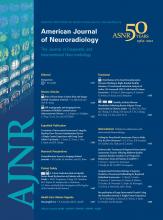Research ArticleTechnical Note
Open Access
Hyperintense Vessel Sign on Fluid-Attenuated Inversion Recovery MR Imaging Is Reduced by Gadolinium
K.A. Dani, L.L. Latour and S. Warach on behalf of the NINDS Natural History of Stroke Investigators
American Journal of Neuroradiology September 2012, 33 (8) E112-E114; DOI: https://doi.org/10.3174/ajnr.A2482
K.A. Dani
aFrom the Section on Stroke Diagnostics and Therapeutics, NINDS, National Institutes of Health, Bethesda, Maryland.
L.L. Latour
aFrom the Section on Stroke Diagnostics and Therapeutics, NINDS, National Institutes of Health, Bethesda, Maryland.
S. Warach
aFrom the Section on Stroke Diagnostics and Therapeutics, NINDS, National Institutes of Health, Bethesda, Maryland.

Submit a Response to This Article
Jump to comment:
No eLetters have been published for this article.
In this issue
Advertisement
K.A. Dani, L.L. Latour, S. Warach
Hyperintense Vessel Sign on Fluid-Attenuated Inversion Recovery MR Imaging Is Reduced by Gadolinium
American Journal of Neuroradiology Sep 2012, 33 (8) E112-E114; DOI: 10.3174/ajnr.A2482
Jump to section
Related Articles
- No related articles found.
Cited By...
- No citing articles found.
This article has been cited by the following articles in journals that are participating in Crossref Cited-by Linking.
- Susan A. Arnold, Simon R. Platt, Karine P. Gendron, Franklin D. WestFrontiers in Veterinary Science 2020 7
- Sang Hee Ha, Jun Young Chang, Sang Hun Lee, Kyung Mi Lee, Sung Hyuk Heo, Dae-il Chang, Bum Joon KimJournal of Stroke and Cerebrovascular Diseases 2021 30 2
- Kyung-Yul Lee, Jin Woo Kim, Mina Park, Sang Hyun Suh, Sung Jun AhnJournal of Neuroradiology 2022 49 3
- Jérôme Hodel, Xavier Leclerc, Mathieu Rodallec, Sophie Gerber, Raphael Blanc, Olivier Outteryck, Samir Benadjaoud, Cécile Rabrait, Mathieu Zuber, Jean-Pierre Pruvo, Marc ZinsEuropean Radiology 2013 23 7
- Zhongchang Wang, Sen ZhangJournal of Complexity in Health Sciences 2018 1 2
- Chunyan Wang, Chuanliu Wang, Yongjun NiFrontiers in Neurology 2024 15
More in this TOC Section
Similar Articles
Advertisement











